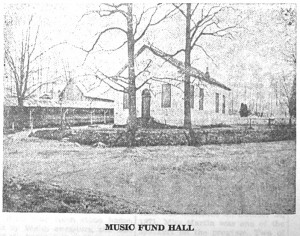Music Fund Hall, the small building shown in the picture illustrating the column this week, was built “some time in or about the year 1832” by “a band of unbelievers in the neighborhood round about.” This neighborhood was then known as Carr’s Corner, now the intersection of Conestoga road and West Wayne avenue.
The picture plainly shows that Music Fund Hall once stood on the exact location of the First Baptist Church, now in process of demolition. The building to the right in the picture was built before Music Fund Hall. Known as the first school in the township, its outside appearance has been little altered by the passing years.
During the period when, as described in last week’s column, “there was a deep religious feeling pervading this portion of the Master’s Vineyard,” there is evidence also that this feeling was by no means all-pervading. While “the prayer circle and the conference room were the delight” of some, there were others who were more worldly-minded.
Among the favorite places of meeting for the deeply religious element was Carr’s School House, the small stone building still standing just to the right of the old Baptist Church. “Here,” according to old records, ” had been enjoyed many seasons of comfortable refreshings from the presence of the Lord – around here were numbers to fill a house at short notice. They turned to this spot, but the Lord ordained otherwise.”
For, whether in a spirit of perversity or because it seemed a suitable location, it was on a piece of ground immediately adjoining the old school house that the “band of unbelievers in the neighborhood” chose to erect a building of their own planning. It was to be one “where gatherings could be had, and of such a character as would draw away the minds of the young from the serious, and thus weaken and eventually overcome the growing religious feeling,” to quote from the old church records.
And “among the foremost in this scheme was Mr. William Siter,” the man who a few years later was to become one of the first four deacons of that early Baptist Church and up to the time of his death always one of its strongest supporters.
In the quaint wording of the old church account of the erection of Music Fund Hall, Mr. Siter “furnished the ground, and the work was started with a will and pushed on with a vigor that was wonderful, in due time the house was finished and ready for the dedication services. It was resolved to open it with a concert. This would not shock the feelings of the people. The affair was published around the neighborhood and the time drew on. At this time there was a protracted meeting in progress at the Great Valley Baptist Church. A Mr. Griswold was the Preacher, and he warned the young to avoid being trapped by the specious title of the meeting, but to bear in mind that whatever gloss they might appear to throw over it, the true object was opposite to the spread of the Redeemer’s Kingdom.”
“The concert was a failure,” is a brief summary in the church account. Whether the “band of unbelievers” tried entertainments in any other form is not recorded. Perhaps they were too discouraged by the failure of their first attempt. At any rate, when a little later “the band” tried to get a title, their plans met with their final setback. For Mrs. Siter refused her name to the title deed!
What happened to Music Fund Hall in the years between 1832 and 1841 is not quite clear in the old records. “The band of unbelievers” collapsed when “Mr. Siter was overtaken by the Holy Spirit and he was a changed man, the things that he once loved he now hated.” At any rate, “after the dissolution of the association the house passed into the hands of brother William Siter, and he offered it to the new interest at less than cost, $700.” By this time it seems to have been known by a more pretentious name than its original one, the later name being “The Radnor Scientific and Musical Hall.”
In 1841 the new interest “paid brother Siter $700 for the building and the ground occupied by the Music Fund Hall.” This was after a petition to the Great Valley Baptist Church had been circulated and signed by some 61 people living in the vicinity of Carr’s Corner. In the petition, request was made for the “construction of a new church.” Once letters had been granted by the Great Valley Church to the persons named in the petition, plans for the meeting place for the new congregation grew rapidly. Certain alterations were made at a price of $246, increasing the total cost of the newly acquired building to $946.
Later on in this same year, that of 1841, the new church built a school house at a cost of “about $300.” As time went by there were other improvements, including horse and buggy sheds, a vault, a parsonage and a stable. This brought the total expenditure up to what seems now the more than modest figure of $2840. By the time the church celebrated its 40th anniversary in 1881, the total expenditure for the church property had grown to $3946, as shown in the report given at that time. Improvements in the interior had included the remodeling of the small church and of the school house. It probably remained without further changes for the next nine years, when in 1890 the large stone edifice that supplanted it was built.
(To be continued)

